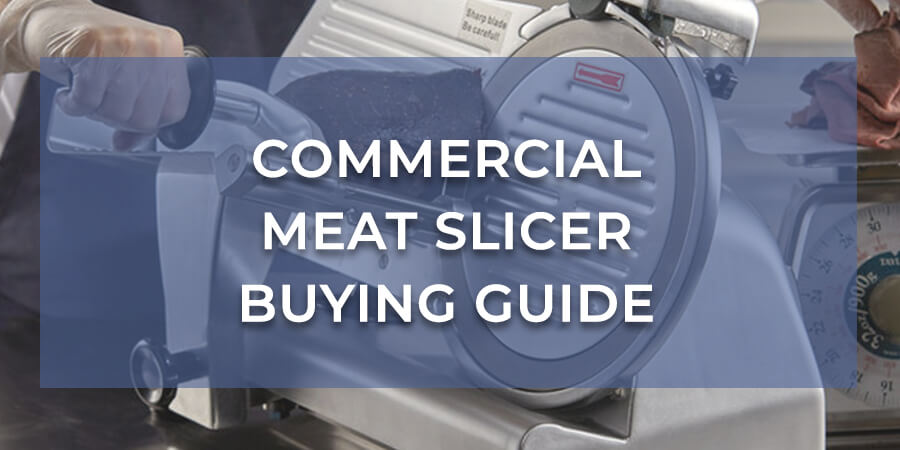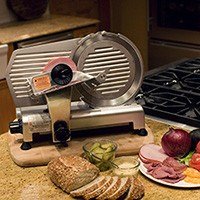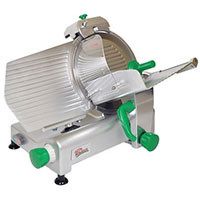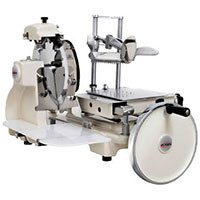Commercial Meat Slicer Buying Guide

When it comes to cutting meat into slices, a good knife will probably be able to do the job. However, we all know that the process is time-consuming – and as much as we hate to admit it, we still can’t get those perfect thin slices, regardless of the practice we put into it.
A meat slicer, on the other hand, will be able to do all that in at least half that time. For people who like to eat sandwiches on a regular basis – but completely hate the cutting part – such a device could literally be a lifesaver.
1. Why Invest In a Meat Slicer?

Let’s face it, not all of us are chefs that can handle slicing meat like pros. Some people cut themselves even handling paper; imagine what would happen if you bring a knife into the mix. Not only would it look disastrous on the table, but it would be disastrous for your safety as well.
Other than the safety issues, why else would we invest in a meat slicer? Well, we can give you several reasons for that:
- Efficiency: While you finish cutting a slice with a knife, a meat slicer would have cut five at the same time. If you have to cut meat every day, multiple times a day, this will lead to a lot of wasted time that you could have used for something else. The day only has 24 hours – so why spend it all in the kitchen?
- Versatility: It’s called a meat slicer, but you can use it to cut more than just meat with it. You can easily slice things such as bread, cheese, fruits, or vegetables with it.
- Ease of Use: Why do the cutting yourself when you might as well have a machine do it automatically for you? You could sit back and enjoy a cup of coffee while the slicer does the job for you.
- Thinner Slices: Sometimes, we want to cut our slices very thin – something that can’t really be achieved with a regular knife. You can, however, achieve it with a meat slicer.
- Uniformity: Every time we try to slice meat with a knife, there will always be that knife that is either too thin, too thick, or has awkward bulges. A meat slicer will ensure that everything is all evened out.
- Money Saver: A lot of us opt for slicing their meat at the grocery store, but that will cost you a lot of money if you do it on a regular basis.
The meat slicer may not be a crucial invention, but purchasing one may sure save you a lot of trouble.
2. Types of Meat Slicers:
When it comes to food slicers, there are two choices for everyone: you either go manual or fully electronic. Both of them are common, but frankly, only one of them actually dominates the entire market.
Electric Meat Slicer

Electric (or automatic) meat slicers are the ones you will find at every kitchen appliance store. They’re usually affordable, very easy to use and not to mention: you don’t have to do anything. The electric motor will move the carriage so that all you’ll have to do is watch.
As the name already implies, this meat slicer will be connected to electricity to do the job, without you having to move a finger – except for placing the food that you want to have sliced and push the start button.
One good example is the Primo PS-10 belt-driven meat slicer. It’s compact and fashionable, with a lot of safety switches and guards to ensure that no harm comes to you during the slicing process.
Manual Meat Slicer

Manual slicers are for those who don’t want to rely on electricity to get the job done for them. They are slower than electric slicers and require that you do some of the handiwork yourself.
If you use the meat slicer for a higher volume of food, this one probably won’t be very practical for you. Since the electric meat slicer came on the market, the manual one became a bit harder to find.
Still, some models are highly popular, such as the Axis AX-VOL12 flywheel meat slicer. With its 12” blade, you may adjust the thickness of the slice up to 2.6 mm. The fixed ring guard is also nicely made, ensuring your safety while you cut to size.
Made from heavy-duty materials, this meat slicer is great for commercial use when you need the device on a daily basis.
4. Design Features to Look For
Aside from the type of meat cutter that you prefer, there are also several features that you might want to consider in this kitchen device. Here are only some of them:
- Horsepower: The more horsepower a meat slicer has, the more frequently you can use it.
- Blade size: An entry-level meat slicer will have around 9”-10” inches blades, whereas professional slicers are around 12”-14”. The Berkel X13A-Plus, for instance, is perfect when it comes to heavy-duty use and cutting all kinds of foods besides meat. On the other hand, slicers like the Eurodib HBS-220JS is perfect for light-duty meat slicing (for instance, if you have to cut meat a few times a day). It can handle low-volume operations and is also very easy to disassemble and clean.
- Belt vs. Gear Driven: Most of the time, you will come across belt-driven meat slicers. Keep in mind, however, that a belt-driven device will be much easier to repair than a gear-driven one (you’ll probably just have to replace the belt. The Axis AX-S13GA is a good example of a gear-driven meat slicer, being equipped with a 0.60 HP motor and gear secured in oil baths that will ensure a noiseless operation.
5. Final Thoughts & Safety Info
A meat slicer can be a great addition to any kitchen. No matter if it’s automatic or electric, it will make the process much safer for you, and allow you to finish the job much faster than with a regular knife. Once you get a slicer good enough to simplify your tasks, it will be hard to live without it after that.

For safety information please click HERE
Share This!